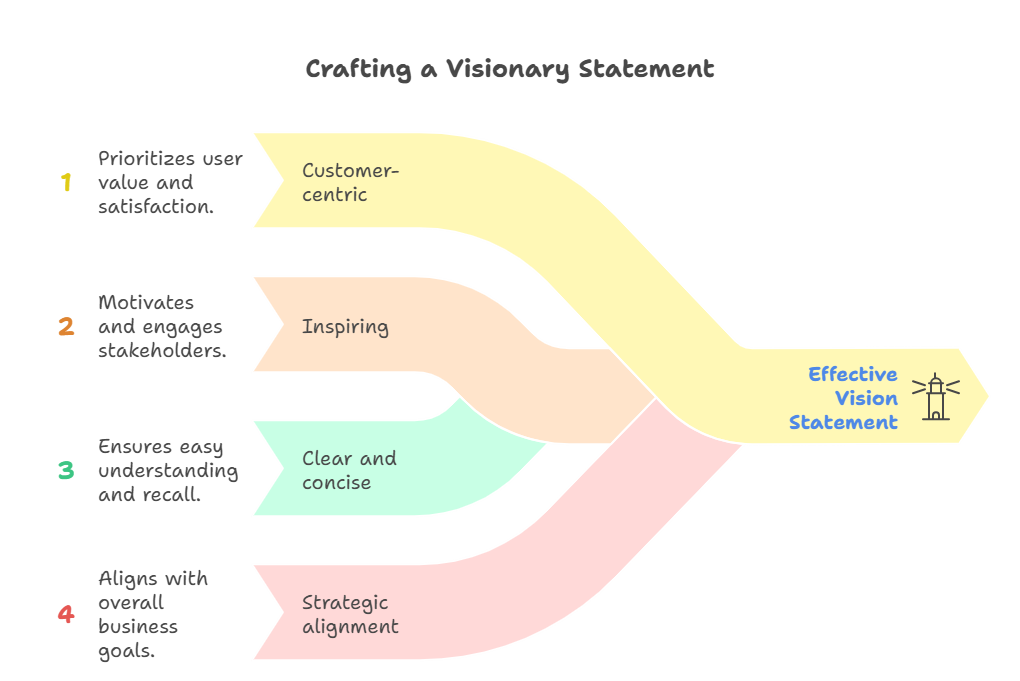How to Communicate a Product Vision Effectively
Learn practical strategies for communicating product vision to stakeholders, teams, and executives using visual tools and clear messaging frameworks.
Why Product Vision Communication Matters
A well-communicated product vision aligns teams, secures stakeholder buy-in, and guides strategic decisions. According to Mural, a purposeful product vision statement ensures teams work toward meaningful goals while integrating with company strategy. Without clear communication, even the most brilliant vision can fail to gain traction.
Effective vision communication bridges the gap between abstract ideas and concrete execution, helping everyone understand not just what you're building, but why it matters.
Craft Your Core Vision Statement
Start with a clear, concise product vision statement that serves as your foundation. Scrum.org recommends framing this as an elevator pitch—a simple statement describing your product's purpose and value.
Your vision statement should be ambitious yet achievable. As Productboard suggests, "make sure it's a stretch, but still realistic." Focus on where you want your product to be, not just where it is today.
Principles of Effective Vision Statements
- Customer-centric: Focus on the value you deliver to users
- Inspiring: Motivate your team and stakeholders
- Clear and concise: Easy to remember and repeat
- Strategic alignment: Connects to broader business objectives

Understand Your Audience
Different stakeholders need different versions of your vision. Executives care about strategic alignment and ROI, while development teams need technical context and customer insights. As highlighted in the LinkedIn strategic guide, understanding your audience is the first step to effective communication.
Tailor your message by considering:
- What each group cares about most
- Their level of product knowledge
- How the vision impacts their work
- What questions they're likely to ask
Use Visuals and Stories
Text alone often fails to convey the emotional impact of a vision. Reddit discussions emphasize showing "anything tangible as much as possible" since "texts and stories are hard to convey the vision."
Visual tools like ClipMind mind maps can transform abstract concepts into clear, structured visual representations that stakeholders can quickly understand and remember.
Effective Visual Communication Methods
- Mockups and prototypes: Show what the future could look like
- Roadmaps: Illustrate the journey from current state to vision
- Customer journey maps: Demonstrate how the vision improves user experiences
- Mind maps: Break down complex vision components into digestible parts
Foster Two-Way Communication
Vision communication shouldn't be a one-way broadcast. The LinkedIn guide emphasizes engaging in two-way communication to build genuine buy-in.
Create opportunities for feedback and discussion through:
- Regular vision review sessions
- Open Q&A forums
- Collaborative workshops
- Feedback channels for ongoing input
Integrate Stakeholder Input
Mural's research stresses the importance of "gathering and integrating stakeholder input" to ensure your vision aligns with user needs and business goals. When stakeholders contribute to the vision, they become advocates for its success.
Consider using tools like ClipMind's AI SWOT Analyzer to systematically evaluate stakeholder perspectives and identify alignment opportunities.
Make Your Vision Tangible
Abstract visions are difficult for people to grasp and support. Find ways to make your vision concrete through demonstrations, prototypes, or detailed scenarios. As one product manager shared on Reddit, "if you can really mock something up, it helps tremendously."
Creating Tangible Vision Artifacts
- Working prototypes: Even basic versions can demonstrate the vision
- Customer success stories: Show how real users would benefit
- Metrics and milestones: Define what success looks like
- Competitive comparisons: Illustrate your unique value proposition
Maintain Consistency and Reinforcement
Communicating your product vision isn't a one-time event. Consistent reinforcement through multiple channels and contexts helps embed the vision into your organization's culture.
Regularly revisit and refine your vision communication based on feedback and changing circumstances. Tools like ClipMind's Project Planner can help you schedule and track ongoing vision communication activities across your organization.
Effective product vision communication transforms abstract ideas into shared understanding and collective action. By combining clear messaging, visual tools, and ongoing dialogue, you can align your entire organization around a common purpose and drive meaningful product success.
 ClipMind
ClipMind